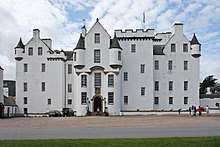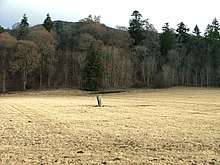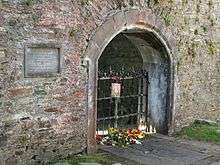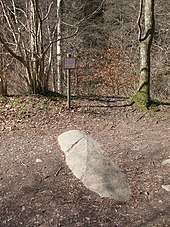Battle of Killiecrankie
The Battle of Killiecrankie (Scottish Gaelic: Blàr Choille Chnagaidh), also referred to as the Battle of Rinrory by contemporaries, took place on 27 July 1689 during the First Jacobite Rising between a Jacobite force of Scots and Irish and those of the new Williamite government. The Jacobites won a stunning victory but suffered heavy casualties, their commander, John Graham, Viscount Dundee, being killed in the final minutes.
| Battle of Killiecrankie | |||||||
|---|---|---|---|---|---|---|---|
| Part of the Jacobite rising of 1689 | |||||||
 Lochiel's charge at Killycrankie, James Grant | |||||||
| |||||||
| Belligerents | |||||||
|
|
| ||||||
| Commanders and leaders | |||||||
|
|
| ||||||
| Strength | |||||||
| 2,440[1] | 3,600–5,100 | ||||||
| Casualties and losses | |||||||
| 800 killed and wounded | 1,700–2,000 killed, wounded and missing | ||||||
| Designated | 21 March 2011 | ||||||
| Reference no. | BTL12 | ||||||
 Location within Scotland | |||||||
Background
James VII and II became King of Scotland and England in February 1685 with widespread support in both countries despite his personal Catholicism.[2] The 1681 Scottish Succession Act confirmed his right to the Crown 'regardless of religion,' while the Test Act required all public officials to swear unconditional loyalty to James.[3]
.jpg)
Both of these contained the crucial qualifier that officials and James 'promise to uphold the true Protestant religion.' Many regarded 'tolerance' of Roman Catholicism as contrary to those commitments and, when Parliament refused to approve his measures, James resorted to arbitrary rule.[4] Dissent became a crisis with the birth of James Francis Edward in June 1688, with the prospect of a Catholic dynasty causing widespread civil disorder.

On 5 November 1688, James' Protestant nephew and son-in-law, William of Orange, landed in England, and James II fled to exile on 23 December. In February 1689, William and his wife Mary II were offered the English throne; on 14 March, a Convention met in Edinburgh to agree a Settlement for Scotland. This was dominated by supporters of the new administration, so-called 'Jacobites' restricted largely to those linked to James by religion or personal ties.[5] The number of activists on either side was tiny, the vast majority being unenthusiastic about either option.[6] On 12 March 1689, James launched the War in Ireland; the Convention offered the Scottish throne to William and Mary on 11 April and, shortly afterwards, Dundee raised James' Royal Standard on Dundee Law.
Initial military actions
William's military commander in Scotland was General Hugh Mackay, head of the veteran Dutch Scots Brigade. His force of 3,500 included the Brigade regiments of Mackay, Balfour and Ramsay, the English Hastings Regiment and two newly raised Scots units. When Ewen Cameron of Lochiel learned of William's landing, he began recruiting men to fight for James but the short-term nature of clan warfare meant it needed to be used as soon as possible.[7]
In April, Dundee joined him at Glenroy and on 18 May, took his force of around 1,800 Highlanders and attempted to bring Mackay to battle. He failed to do so and returned in June, after which most of the clansmen went home, leaving him with less than 200 men.[8]
On 27 June, Dundee wrote to the Earl of Melfort asking for reinforcements; the loss of Kintyre after the Battle of Loup Hill made resupply from Ireland extremely difficult and the letter details alternative landing spots. As time went on, his position weakened due to continued defections, the surrender of Edinburgh Castle on 14 June being especially discouraging.[9] The only reinforcements he received was a contingent of 300 Irish soldiers under Alexander Cannon, who landed near Duart on 21 July. This was partly due to an internal dispute between mostly Catholic 'Non-Compounders,' who dominated James' court in Ireland and urged him to refuse any concessions to regain his throne, and Protestant 'Compounders' in Scotland like Dundee for whom such concessions were seen as essential.[10]
A Jacobite garrison under Patrick Stewart of Ballechin occupied Blair Castle, a strategic point controlling access to the Lowlands and seat of the Duke of Atholl. This illustrates how many families balanced both sides; claiming ill-health, Atholl went to England, leaving his eldest son John Murray to 'besiege' his ancestral home. Stewart himself was a trusted family retainer and one of Atholl's key lieutenants in the suppression of Argyll's Rising in 1685.[11]
In late July, Jacobite reinforcements arrived at Blair; Murray withdrew and Mackay moved north to support him. Seeing a chance to intercept Mackay, Dundee set out with his available forces, ordering the clans to follow "with all haste." Lochiel's sons were sent to raise additional levies; he and 240 Camerons plus Cannon's Irish contingent reached Blair on 26 July.
Battle
On the morning of 27 July, Dundee learned Mackay's forces were entering the Pass of Killiecrankie, a track nearly two miles (3 km) long with the River Garry on the left and steep hills on either side. Sir Alexander McLean and 400 men were sent to skirmish with the advance guard, while Dundee assembled his 2,400 troops on the lower slopes of Creag Eallich, north of the pass. The Williamite government army now had the Jacobites on the high ground above and the river behind, while the narrow track made advance or retreat equally hazardous. Mackay halted, moved off the track and deployed his troops facing uphill in a long line only three men deep to maximise firepower.[12]
Mackay's force included Balfour, Ramsay and Mackay's Regiments of the Scots Brigade, the new recruits of Kenmure and Lord Leven, part of the English Hastings Regiment of Foot and 50 men from the Earl of Annadale's Scots horse.[13] The experienced Scots Brigade regiments under Balfour and 200 fusiliers led by Lauder were placed on the left with the best field of fire.

The Jacobites formed into columns and were in position by late afternoon but Dundee waited until sunset or about 8:00 pm to begin his attack. Balfour's line fired three volleys, killing nearly 600 Highlanders but their fire was partly masked by a shallow terrace on the hillside while the right flank apparently fled without firing a shot.[14] Following their usual tactics, the Highlanders fired a single volley at 50 metres, dropped their muskets and using axes and swords crashed into Mackay's centre which was "swept away by the furious onset of the Camerons."
Killiecrankie is the first recorded use by British troops of the plug bayonet which increased firepower by eliminating pikemen but required training and confidence in its use. The bayonet fitted into the barrel of the musket (hence 'plug'), preventing further reloading or firing and so fixing them was delayed until the last possible moment.[15] Inexperience and the speed of the Highland charge left Mackay's men defenceless at close quarters and the battle was over in less than 30 minutes. Retreat turned into a rout with over 2,000 killed, including Balfour and James Mackay, younger brother of Hugh, who broke through the Jacobite lines with a small cavalry escort.[16]
Mackay with 500-800 others made it back to Stirling with relative ease; the Highlanders stopped to loot the baggage train and were in no condition to pursue him. Their casualties had been enormous, with nearly one third killed, including Dundee himself, who was fatally wounded towards the end. A letter under his name sent to James with details of the victory is generally thought to be a forgery but a useful summary of the action itself.[17] Dundee was replaced as commander by Alexander Cannon.[18]
Legacy


A ceremony is held each year at a memorial cairn known as Tomb Clavers located near the centre of the government positions. It is the subject of four songs known as "The Braes o' Killiecrankie" included in Jacobite Reliques, a collection published by James Hogg in 1819. The battle and events leading up to it are the centrepiece of Rosemary Sutcliff's 1986 novel 'Bonnie Dundee' and 'A Summer in Lochaber' by Catriona Fforde.
In 2004, a fragment of a hand grenade was found, providing evidence of their first use in Britain 30 years earlier than that previously recorded at Glen Shiel in 1719.[19] Between August and October 2015, an archaeological survey of the site was undertaken in preparation for the improvement of the A9 road.[20] Finds included a copper alloy pendant, horse shoes, buttons, bullets, two buckles and part of the support for a sword belt. Transport Minister Derek Mackay said "Thanks to the survey work, experts are shedding more light on the Battle of Killiecrankie which took place over three hundred years ago, bringing 'Bonnie Dundee's' Jacobite victory to life. They are able to offer more information on the battle including the possible route soldiers took during the battle, potential cavalry positions, where the key skirmishes and close quarters fighting took place, and the likely route taken by the fleeing government forces."[21][22]
The battlefield is included in the Inventory of Historic Battlefields in Scotland and protected by Historic Scotland under the Scottish Historical Environment Policy (HES) of 2009. HES and a number of interest groups have objected to the extent of the survey and the proposed route of the new road; these provide perspective on the unique features of the battlefield itself.[23]
Notes
References
- The Inventory of Historic Battlefields – Battle of Killiecrankie (pdf). Edinburgh: Historic Scotland. 2011. Retrieved 19 January 2020.
- Revolution; the Great Crisis of the British Monarchy 1685–1720 Tim Harris 2005 pp.39-65
- Restoration Scotland, 1660–1690: Royalist Politics, Religion and Ideas; Clare Jackson 2003 pp.38-54
- Revolution; the Great Crisis of the British Monarchy 1685–1720, Tim Harris 2005 pp.153-178
- Coward, Barry (1980). The Stuart Age 1603-1714. Longman. p. 459. ISBN 0582488338.
- Lenman, Bruce (1995). The Jacobite Risings in Britain, 1689-1746. Scottish Cultural Press. p. 35. ISBN 189821820X.
- Fritze Ronald, Robison William (1996). Historical Dictionary of Stuart England, 1603-1689. Greenwood. pp. 68–70. ISBN 0313283915.
- Macpherson, James (1775). Original Papers: Containing the Secret History of Great Britain (2017 ed.). Hansebooks. pp. 357–358. ISBN 3743435721.
- Macpherson, James (1775). Original Papers: Containing the Secret History of Great Britain (2017 ed.). Hansebooks. pp. 360–366. ISBN 3743435721.
- Szechi, Daniel (1994). The Jacobites: Britain and Europe, 1688-1788. Manchester University Press. pp. 30–31. ISBN 0719037743.
- Kennedy, Allan (2016). "Rebellion, Government and the Scottish Response to Argyll's Rising of 1685" (PDF). Journal of Scottish Historical Studies. 36 (1): 8. doi:10.3366/jshs.2016.0167.
- Macpherson, James (1775). Original Papers: Containing the Secret History of Great Britain (2017 ed.). Hansebooks. pp. 369–371. ISBN 3743435721.
- Mackay, John (1836). Life of Lieut.-Gen. Hugh Mackay of Scoury: Commander-in-Chief of the Forces in Scotland, 1689 and 1690 (2017 ed.). Forgotten Books. pp. 52–54. ISBN 1333263538.
- Oliver Neil, Pollard Tony (2003). Two Men in a Trench II: Uncovering the Secrets of British Battlefields (2015 ed.). Penguin. ISBN 0141012129.
- http://www.battlefieldsofbritain.co.uk/battle_killiecrankie_1689.html
- Hill, James (1986). Celtic Warfare 1595-1763 (2017 ed.). Dalriada Publishers. p. 73. ISBN 097085255X.
- Macpherson, James (1775). Original Papers: Containing the Secret History of Great Britain (2017 ed.). Hansebooks. pp. 372–373. ISBN 3743435721.
- John Leonard Roberts, Clan, King, and Covenant: History of the Highland Clans from the Civil War to the Glencoe Massacre (Edinburgh University Press, 2000), 195-97. ISBN 0748613935
- "First grenade found at Killiecrankie". The Scotsman. 22 February 2004. Retrieved 4 March 2016.
- "Killiecrankie Battlefield Metal Detecting Survey". GUARD Archaeology. March 2016. Archived from the original on 6 March 2016. Retrieved 4 March 2016.
- Ferguson, Brian (3 March 2016). "Dozens of Battle of Killiecrankie artefacts unearthed at A9 roadworks". The Scotsman. Retrieved 4 March 2016.
- "Battle of Killiecrankie artefacts found during A9 dualling survey". BBC News Online. 3 March 2016. Retrieved 4 March 2016.
- Historic Environment Scotland. "Response to proposed A9 route dated 23.01.18". Historic Environment Scotland. Retrieved 4 June 2018.
Sources
- Coward, Barry; The Stuart Age 1603-1714; (Longman, 1980);
- Fritze, Ronald & Robison, William; Historical Dictionary of Stuart England, 1603-1689; (Greenwood, 1996);
- Harris, Tim; Revolution; the Great Crisis of the British Monarchy 1685–1720; (Penguin, 2007);
- Hill, Michael; Celtic Warfare 1595-1763; (John Donald Publishers, 1986);
- Jackson, Clare; Restoration Scotland, 1660–1690: Royalist Politics, Religion and Ideas; (Boydell Press, 2003);
- Lenman, Bruce; The Jacobite Risings in Britain, 1689-1746. (Scottish Cultural Press, 1996);
- Macpherson, James; Original Papers: Containing the Secret History of Great Britain; (Hansebooks, 1795);
- Neil, Oliver, Pollard, Tony; Two Men in a Trench II: Uncovering the Secrets of British Battlefields; (Penguin, 2015 ed.);
External
- Historic Environment Scotland. "Battle of Killiecrankie (BTL12)".
- Article on the battle at Electric Scotland
- Reid, Stuart (2009). The Battle of Kiellliecrankkie. Partizan Press.CS1 maint: ref=harv (link)
- Historic Scotland. "The Inventory of Historic Battlefields – Battle of Killiecrankie" (PDF). Historic Scotland. Retrieved 18 December 2017.
- Fforde, Catriona; A Summer in Lochaber; (House of Lochar, 2002);
- Sutcliffe, Rosemary; Bonnie Dundee; (Random House, 1986);
.svg.png)